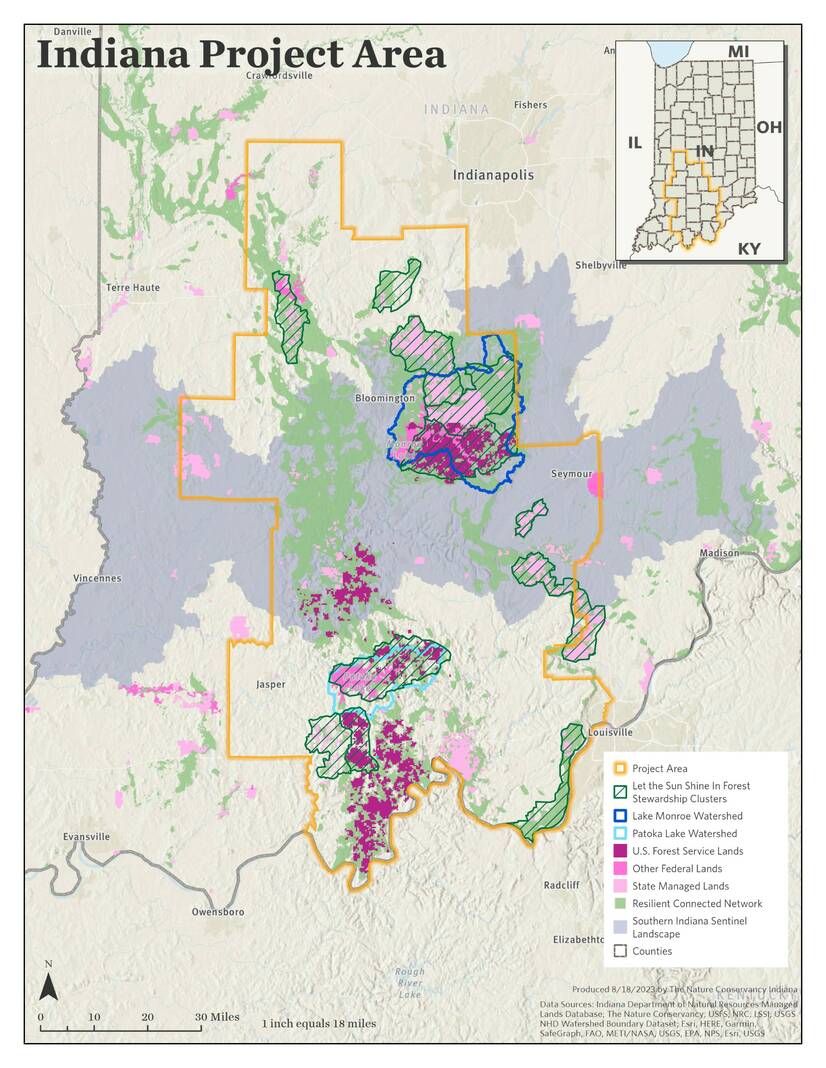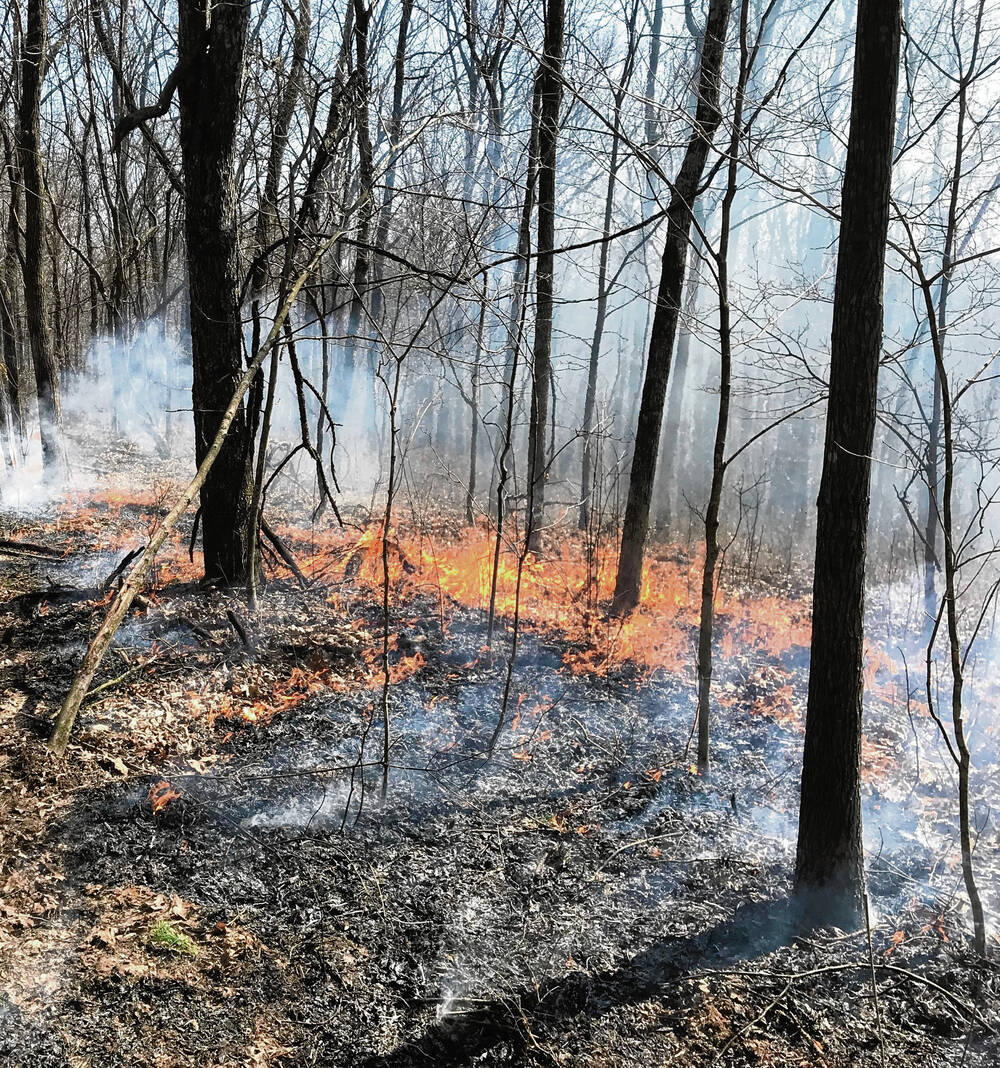

Prescribed fire is a tool to help restore southern Indiana’s oak ecosystems.
Submitted photo
Under the Joint Chiefs’ Landscape Restoration Partnership program, the U.S. Department of Agriculture’s Natural Resources Conservation Service and Forest Service have received funding to work together and with partners to improve the health and resiliency of public and private forest lands in southern Indiana.
“Joint Chiefs’ provides an excellent opportunity for the Forest Service and NRCS to partner on forestry-based landscape scale projects,” said Dan Shaver, the Indiana NRCS state forester. “In Indiana we have a very tight-knit forestry community, and we are always looking for ways to get more information, financial assistance and resources to our woodland owners to implement good conservation. We have applied for Joint Chiefs’ multiple times, but this is only the second time Indiana has been awarded a project.”
In June, funds were made available by the USDA for projects around the country.
The partnerships are collaborative efforts between the NRCS and the Forest Service that aim to work with private, state and tribal landowners to conserve forest and agricultural land alongside federally managed lands while safeguarding communities by reducing the impact of wildfire threats and protecting water quality and supply.
Staff from the Hoosier National Forest and the USDA Indiana NRCS office applied together and as a result the agencies received $7.9 million for the “Ready-Set-Fire in White Oak Woodlands” project which aims to expand woodland conservation and restoration for fire dependent plant communities, benefit local water supplies, improve habitat for at risk forest dependent songbird and improve the continuity of habitat between public and private land over the next three years.
“The ‘Ready-Set-Fire in White Oak Woodlands’ project will allow us to implement on-the-ground forest conservation work and use appropriate prescribed fires in more places to enhance habitat for at-risk species and forest community types,” said Jeremiah Heise, the Hoosier National Forest ecosystem program manager. “This project is a capacity building effort that will allow us to have a greater restoration impact at a true landscape scale.”
The project will specifically target the restoration of upland oak ecosystems, which have been declining and will continue to be lost without active forest management.
“This project is important because it addresses the critical need of oak ecosystem management on both public and private land in southern Indiana,” Shaver said. “If you walk into the woods in southern Indiana, it’s easy to take for granted the beautiful mature oak trees you can find. But if you look closely and pay attention, you can see that the forest system is suffering a man-made problem. Due to the lack of appropriate fire and forest management that is needed to let enough light into the forest, as well as too many deer, we’re losing the next generation of oak woodlands in Indiana.
“This lack of oak forest regeneration and management is creating a commotion in our oak ecosystems that will ripple through and be detrimental to an amazing diversity of plants, animals and ourselves if we are not forward thinking and take steps now to help sustain our oak ecosystems.”
Prescribed fire is a tool used by land managers to restore habitats and reduce the impacts and severity of wildfires. Through this project, the Forest Service is partnering with The Nature Conservancy to fund a prescribed fire strike team that will implement prescribed fires across 16 counties in southern Indiana to improve habitat for at-risk species and reduce wildfire risk. Funding also will be provided to the conservancy to administer oak barrens and glade habitat restoration in southern Indiana, unique habitats that have seen drastic reductions in acreage due to the need for management and the removal of beneficial fire from the landscape.
“The combination of forest management and prescribed fires that will take place due to this funding will restore and reinvigorate the declining white oak woodlands in southern Indiana, reduce wildfire risk, and aid in forest resiliency to predicted impacts of a changing climate,” said Heise said.
The project includes funding for prescribed fire monitoring in cave and karst areas, equipment for the strike team, invasive species control and prepping for and implementing prescribed fires. As the Forest Service and the NRCS use these science-based management tools to create a mosaic of diverse forest habitats across the Indiana forest landscape, they’ll partner with many different organizations along the way.
“Along with NRCS, we’re looking forward to partnering with The Nature Conservancy, the Southern Indiana Sentinel Landscape, the Indiana Department of Natural Resources Division of Forestry, and the Central Hardwood Joint Venture’s – Let the Sun Shine In program in Indiana to increase the amount of forest stand improvement, non-native invasive species control, and appropriate prescribed fire that is implemented in Brown, Crawford, Dubois, Floyd, Greene, Harrison, Jackson, Lawrence, Martin, Monroe, Morgan, Orange, Owen, Perry, Putnam, and Washington Counties,” Heise said.
Private landowners from these counties who are interested in forest conservation and management on their land should reach out to their local USDA Service Center to find out more information and submit applications for funding. In Jackson County, the service center is located at 1350 Woodside Drive in Brownstown. The number is 812-358-2367.
“On the private land side, we have more landowners wanting to be good stewards and manage their forestland to control non-native invasive plants and help restore oak ecosystems than we can help with our traditional Farm Bill conservation programs,” Shaver said. “’The Ready-Set-Fire in White Oak Woodlands’ Joint Chiefs’ project provides a dedicated source of conservation funding for three years to assist landowners in the 16-county area with their woodland management projects. It is timely and focused on a critical need that will accelerate oak ecosystem restoration and prepare woodlands for the next step in oak ecosystem management.”
Since 2014, USDA has invested more than $423 million in 134 projects in 42 states, as well as Guam and Puerto Rico, through the Joint Chiefs’ Landscape Restoration Partnership. These projects focus on areas where public forests and grasslands intersect with privately-owned land, delivering important funding to improve and maintain the health of forests and rangeland.
For information visit nrcs.usda.gov/programs-initiatives/joint-chiefs-landscape-restoration-partnership.
